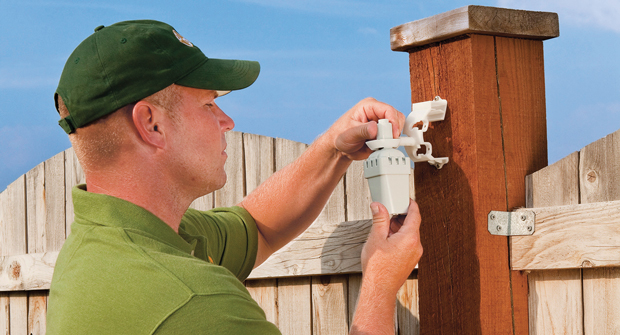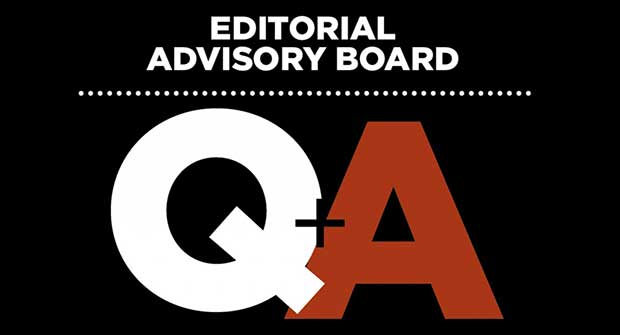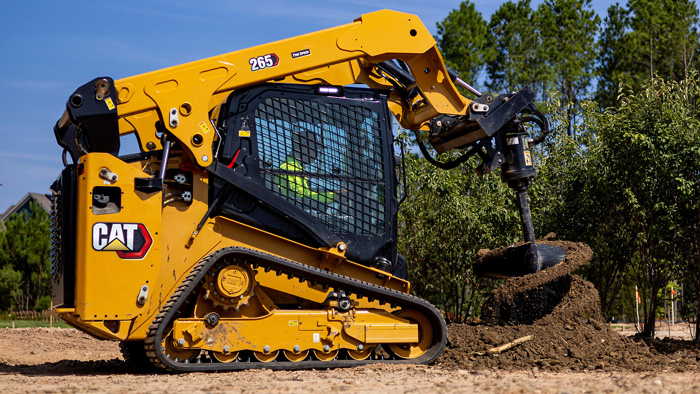
Simple rain and freeze sensors prevent residential and commercial irrigation systems from running when weather and climate conditions deem irrigation unnecessary. Early versions of the sensors, still in use, are hardwired between the sensor and the controller. However, in modern devices, the receiver plugs into the controller and then, via a low-frequency radio, wirelessly communicates to the sensor mounted on a building eave or rain gutter.
“These tools are simple, and the cost is relatively low —between $50 and $75, in most cases,” says Matthew Hall, a product marketing manager for residential and light commercial controllers for Irritrol. “And the added efficiency the sensor provides to an irrigation system generates an ROI in short order.”
Location matters
Proper installation is critical for sensors to work correctly. Technicians should place the device in a location unobstructed by trees or other landscape objects and position it in an area where curious animals, maintenance crews or potential vandalism won’t damage it. Most importantly, technicians must position the sensor to expose it to the elements.
At its heart, a rain sensor has a hygroscopic fiber disc, made of synthetic material that expands when wet. When rain saturates that disc, it swells to a point that initiates the sensor to turn the irrigation system off. The irrigation system remains off until the disc dries to a point to be activated by the next rain event.
“When you install the sensor, be certain it’ll get rained on and be exposed to the sun, but not be influenced by your irrigation system,” Hall says. “And because it’s a wireless sensor, you want it located within some reasonable line-of-sight of the receiver so as not to impede the signal.”
While routine maintenance is minimal, ensuring the sensors function properly is critical.
“These sensors are designed to be set-and-forget devices,” says Gregg Black, operations manager at Jain Irrigation. “There is some calibration, per se, that can be checked regularly to ensure it disables the irrigation when it rains or, in the case of a freeze or rain/freeze sensor, the temperature reaches a certain point to initiate the sensor.”
Overall, contractors should inspect the sensors as part of their annual irrigation system check and consider replacing the device’s hygroscopic fiber disc every two years or perhaps more frequently if they’re in a high-rain region, Black says. In addition, techs should replace the sensors’ power sources (typically a coin-sized battery) every two years.
“Of course, a good indication that the sensor needs maintenance is if the irrigation is running during a rain event,” he says.
Not just for Northern climates
It’s important to remember freeze sensors aren’t just for Northern states, Steve Barendt, controller product manager with Rain Bird Corp., says.
“You can set these sensors to different temperature thresholds to irrigate … say down to 40 degrees at the very minimum,” he says. “And we absolutely see those temperatures here in Austin, where I’m based. In fact, a couple of years ago, we had a hard freeze and several inches of snow, and you could drive down the street and see people’s irrigation active.”
In addition to conserving water, freeze sensors address safety and liability issues that stem from throwing water on the ground in near-freezing temperatures.
“Overspray can create icy pavement surfaces, creating a potential slip-and-fall hazard,” Barendt adds.
Many municipalities throughout the country mandate rain and rain/freeze sensors in irrigation systems, even outfitted with weather-based evapotranspiration (ET) controllers.
“My recommendation is always to use (ET controllers and rain/freeze sensors) as supplements to one another,” Barendt says. “For the most efficient system, a local sensor is better than any information you can gather from data or weather-based services. Working together, they’re an effective method of delaying irrigation and ensuring you’re not wasting water.”

